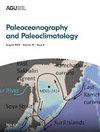Meridional Heat Transport in the DeepMIP Eocene Ensemble: Non‐CO2 and CO2 Effects
IF 3.2
2区 地球科学
Q2 GEOSCIENCES, MULTIDISCIPLINARY
引用次数: 0
Abstract
The total meridional heat transport (MHT) is relatively stable across different climates. Nevertheless, the strength of individual processes contributing to the total transport are not stable. Here we investigate the MHT and its main components especially in the atmosphere, in five coupled climate model simulations from the Deep‐Time Model Intercomparison Project (DeepMIP). These simulations target the early Eocene climatic optimum, a geological time period with high CO2 concentrations, analog to the upper range of end‐of‐century CO2 projections. Preindustrial and early Eocene simulations, at a range of CO2 levels are used to quantify the MHT changes in response to both CO2 and non‐CO2 related forcings. We found that atmospheric poleward heat transport increases with CO2, while oceanic poleward heat transport decreases. The non‐CO2 boundary conditions cause more MHT toward the South Pole, mainly through an increase in the southward oceanic heat transport. The changes in paleogeography increase the heat transport via transient eddies at the northern mid‐latitudes in the Eocene. The Eocene Hadley cells do not transport more heat poleward, but due to the warmer atmosphere, especially the northern cell, circulate more heat in the tropics, than today. The monsoon systems' poleward latent heat transport increases with rising CO2 concentrations, but this change is counterweighted by the globally smaller Eocene monsoon area. Our results show that the changes in the monsoon systems' latent heat transport is a robust feature of CO2 warming, which is in line with the currently observed precipitation increase of present day monsoon systems.深mip始新世整体中的经向热输运:非CO2和CO2效应
总经向热传输(MHT)在不同气候下相对稳定。然而,单个过程对总运输的贡献强度并不稳定。在这里,我们在深度时间模型相互比较项目(DeepMIP)的五个耦合气候模型模拟中研究了MHT及其主要成分,尤其是在大气中。这些模拟的目标是始新世早期的最佳气候,这是一个二氧化碳浓度高的地质时期,类似于本世纪末二氧化碳预测的上限。工业化前和始新世早期的模拟,在一系列二氧化碳水平下,用于量化MHT对二氧化碳和非二氧化碳相关强迫的变化。我们发现,大气向极地的热传输随着二氧化碳的增加而增加,而海洋向极地的热量传输则减少。非CO2边界条件导致更多的MHT向南极移动,主要是通过增加向南的海洋热传输。古地理的变化增加了始新世中纬度北部通过瞬态涡旋的热传输。始新世哈德利细胞并没有向极地输送更多的热量,但由于大气变暖,尤其是北部细胞,在热带地区的热量比今天循环得更多。季风系统的极地潜热输送随着二氧化碳浓度的上升而增加,但这种变化被全球较小的始新世季风区抵消了。我们的研究结果表明,季风系统潜热输送的变化是二氧化碳变暖的一个显著特征,这与目前观测到的当今季风系统降水量的增加是一致的。
本文章由计算机程序翻译,如有差异,请以英文原文为准。
求助全文
约1分钟内获得全文
求助全文
来源期刊

Paleoceanography and Paleoclimatology
Earth and Planetary Sciences-Atmospheric Science
CiteScore
6.20
自引率
11.40%
发文量
107
期刊介绍:
Paleoceanography and Paleoclimatology (PALO) publishes papers dealing with records of past environments, biota and climate. Understanding of the Earth system as it was in the past requires the employment of a wide range of approaches including marine and lacustrine sedimentology and speleothems; ice sheet formation and flow; stable isotope, trace element, and organic geochemistry; paleontology and molecular paleontology; evolutionary processes; mineralization in organisms; understanding tree-ring formation; seismic stratigraphy; physical, chemical, and biological oceanography; geochemical, climate and earth system modeling, and many others. The scope of this journal is regional to global, rather than local, and includes studies of any geologic age (Precambrian to Quaternary, including modern analogs). Within this framework, papers on the following topics are to be included: chronology, stratigraphy (where relevant to correlation of paleoceanographic events), paleoreconstructions, paleoceanographic modeling, paleocirculation (deep, intermediate, and shallow), paleoclimatology (e.g., paleowinds and cryosphere history), global sediment and geochemical cycles, anoxia, sea level changes and effects, relations between biotic evolution and paleoceanography, biotic crises, paleobiology (e.g., ecology of “microfossils” used in paleoceanography), techniques and approaches in paleoceanographic inferences, and modern paleoceanographic analogs, and quantitative and integrative analysis of coupled ocean-atmosphere-biosphere processes. Paleoceanographic and Paleoclimate studies enable us to use the past in order to gain information on possible future climatic and biotic developments: the past is the key to the future, just as much and maybe more than the present is the key to the past.
 求助内容:
求助内容: 应助结果提醒方式:
应助结果提醒方式:


